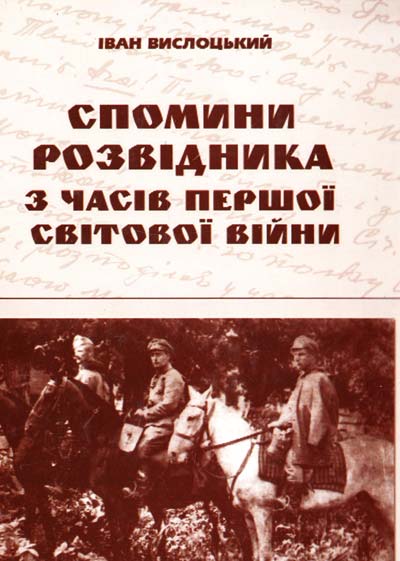Gallery of Нeroes
Intelligence Officer of the Ukrainian Galician Army of the Western Ukrainian People’s Republic
Ivan Vyslotskyi
Future intelligence starshyna (senior officer) Ivan Vyslotskyi was born on July 24, 1893 in the family of a priest in the village of Leliukhiv, Novyi Sanch district, Lemkivshchyna region.

Ivan Vyslotskyi inscribed his name in the history of Ukrainian intelligence having written detailed memoirs about his service in the Intelligence Department of the Ukrainian Galician Army (UGA) and the activities of intelligence service in that difficult period of life of the Ukrainian state.
At the age of 18 years, he as a volunteer joined the Austrian army, later graduated from the Intelligence School in Bregenz, then he was engaged in specific tasks at the headquarters of the corps, based in Przemysl. During the First World War, he was in Russian captivity and was taken to Chita, and later to Ufa. In 1917, he along with other Ukrainian prisoners from Halychyna got (with lots of adventures) to Kyiv, where he joined the Sich Riflemen Corps in the rank of a platoon leader and later he was promoted to Khorunzhyi (Ensign).
After the establishment in November 1918 of the Western Ukrainian People’s Republic, a regular Ukrainian Galician Army began being formed to protect its statehood. An important place in its structure was given to the Intelligence Department which structurally was subordinated to the Supreme Command – the highest commandment of the UGA.
The initiator of the establishment of the Intelligence Service in the Galician Army became the Commander of the UGA Colonel Dmytro Vitovskyi. The Chief of the Intelligence Department in early 1919 was appointed Lieutenant Rodion Kovalskyi, who, according to archival documents, was also a “Chief of the Intelligence Service”. The Department included units that were engaged in both intelligence and counterintelligence activities. The intelligence officers were called detectives. One of the detectives, who had been acquainted with Vyslotskyi since their service in the Austrian Army, once in the spring of 1919 happened to meet him on the street and offered to return to the Intelligence Service. Having received Vyslotskyi’s prior consent, he introduced him to the Chief of the Department Kovalskyi. A short conversation about the previous service made quite a positive impression and Vyslotskyi became a senior officer of the Intelligence Department.
“This department was the leader of the entire Intelligence Service, – wrote in his memoirs Ivan Vyslotskyi, – and was originally called Vyvidchyi (Investigation) Department, abbreviated VV, and later, until the end of its existence, the Department was called Rozvidchyi (Intelligence) Department or RV. It included senior intelligence officers of brigade command and of district support commands in Halychyna, as well as senior officers who were at some important places on both sides of then Ukrainian-Polish front and border with Romanians”. Besides, there were units of field reconnaissance, aerial reconnaissance, “propaganda” department, which organized information propaganda activities.
The work of the Intelligence Service of that time by the stages can be divided into two main periods: Galician period, during which there was the long war with Poland, and Dnieper period, when there were combat actions against the Red and Volunteer armies. The UGA intelligence officers also collected information about their co-allies – the Acting UPR’s Army, because they had a good reason to do so. Vyslotskyi was sent to the Dnieper region with one of such tasks as the only intelligence officer who knew well the territory. Upon his return, he wrote a detailed report on everything he had seen.

But perhaps the intelligence officer’s most significant achievement was the successful fulfillment of another task in the rear area of the Bolshevik troops. He had to pass by the southern wing of Bolshevik Front, to go into the rear area and to learn what kind of manoeuvres used by the retreating, and most importantly – to find out whether the Bolshevik had tanks there.
Vyslotskyi spent fortnight among the enemies, risking to draw their attention, and found out that the Bolshevik did have tanks, but sent them against the Volunteer Army. For the fulfillment of this task, he was promoted to the rank of Chotar (platoon leader).
In spring of 1920, the UGA and its security services actually ceased their regular activities. At that, the majority of army officers and riflemen, intelligence and counter-intelligence staff went underground, joined insurrectional-guerilla forces and national liberation movements as well as continued the struggle for independence and unity of the Ukrainian state.
Similar fate befell Ivan Vyslotskyi. With false passports, he with his wife, managed (with adventures) through Odesa, Varna and Belgorod to get to Vienna. Then he moved to the Trans-Carpathian Ukraine, which at that time was a part of the Czechoslovak Republic.
In 1936-1939, he worked in Lviv publishing house.
Before the arrival of the Red Army in September 1939 he and his family got to his native Lemkivshchyna land, and in autumn 1941 he settled in Sambir, where he was publishing new school textbooks without communist stereotypes. In 1944, his family and he found themselves in the camp for displaced persons in Germany, from where in 1948 he left for Paraguay.
Overseas in his later years, he taught children of immigrants to read and write in Ukrainian.
He died in Argentine in 1969.